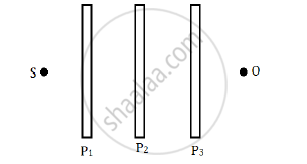Advertisements
Advertisements
Question
An unpolarised light of intensity 32 Wm-2 passes through three Polaroids such that the axes of the first and the last Polaroids are at 90°. What is the angle between the axes of the first and middle Polaroids so that the emerging light has an intensity of only 3 Wm-2?
Solution
Given: I = 3 Wm-2, I0 = 32Wm-2, θ = ?
∴ `"I"_circ = "KA"^2`
I = K AR2
I = `("K A"^2)/2 cos^2 theta sin^2 theta`
`"A"_"R" = "A"/sqrt2 cos theta sin theta`
`"I" prop "AR"^2`
I = `"I"_0/2 4/4 cos^2theta sin^2theta`
I = `"I"_0/8 (2 cos theta sin theta)^2`
I = `"I"_0/8 (sin 2 theta)^2`
`3 = 32/8 (sin 2 theta)^2`
`(sin 2 theta)^2 = 3/4`
`(sin 2 theta) = sqrt3/2`
2θ = 60°
θ = 30°
APPEARS IN
RELATED QUESTIONS
If the critical angle of a medium is sin-1(3/5), find the polarising angle.
Three identical polaroid sheets P1, P2 and P3 are oriented so that the pass axis of P2 and P3 are inclined at angles of 60° and 90° respectively with the pass axis of P1. A monochromatic source S of unpolarised light of intensity I0 is kept in front of the polaroid sheet P1 as shown in the figure. Determine the intensities of light as observed by the observer at O, when polaroid P3 is rotated with respect to P2 at angles θ = 30° and 60°.

What dose a polaroid consist of?
Using the phenomenon of polarisation, show how the transverse nature of light can be demonstrated.
The refractive indices of water for red and violet colours are 1.325 and 1.334 respectively.
Find the difference between the velocities of rays for these two colours in water. (c = 3 × 108 m/s)
What is the value of refractive index of a medium of polarising angle 60°?
Show using a proper diagram how unpolarised light can be linearly polarised by reflection from a transparent glass surface.
Unpolarised light is incident on a polaroid. How would the intensity of transmitted light change when the polaroid is rotated?
A beam of light is incident at the polarizing angle of 35° on a certain glass plate. The refractive index of the glass plate is :
A ray of ordinary light is travelling in air. It is incident on air glass pair at a polarising angle of 56°. Find the angle of refraction in glass.
Light transmitted by Nicol prism is ______.
What is a analyser?
What is the angle of polarisation and obtain the equation for an angle of polarisation?
Discuss about pile of plates.
Discuss about Nicol prism.
The reflected light is found to be plane polarised when an unpolarized light falls on a denser medium at 60° with the normal. Find the angle of refraction and critical angle of incidence for total internal reflection in the denser to rarer medium reflection.
A plane mirror produces a magnification of
Can reflection result in plane polarised light if the light is incident on the interface from the side with higher refractive index?
